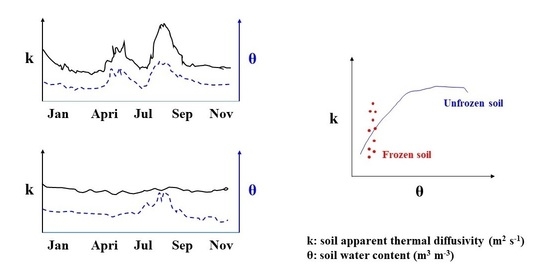Determination of Long-Term Soil Apparent Thermal Diffusivity Using Near-Surface Soil Temperature on the Tibetan Plateau
Abstract
:1. Introduction
2. Materials and Methods
2.1. Site Description
2.2. Observations
2.3. The Method Used to Determine Soil Apparent Thermal Diffusivity
2.4. Data Processing
3. Results
3.1. The Variations of Soil Moisture
3.2. The Variations of Soil Apparent Thermal Diffusivity
3.3. The Relationship between Soil Apparent Thermal Diffusivity and Moisture
4. Discussion
4.1. The Variations of Soil Apparent Thermal Diffusivity
4.2. The Relationship between Soil Apparent Thermal Diffusivity and Soil Moisture
4.3. Limitations
5. Conclusions
Supplementary Materials
Author Contributions
Funding
Data Availability Statement
Acknowledgments
Conflicts of Interest
Appendix A. Determination of Soil Temperature Amplitude and Phase with DHR
References
- Horton, R. Soil thermal diffusivity. In Methods of Soil Analysis: Part 4—Physical Methods; Soil Science Society of America Book Series; Dane, J.H., Topp, G.C., Eds.; Soil Society of America: Madison, WI, USA, 2002; Volume 5, pp. 349–360. [Google Scholar]
- Zhang, T.; Osterkamp, T.E. Considerations in determining thermal diffusivity from temperature time series using finite difference methods. Cold Reg. Sci. Technol. 1995, 23, 333–341. [Google Scholar] [CrossRef]
- Passerat de Silans, A.M.B.; Monteny, B.A.; Lhomme, J.P. Apparent soil thermal diffusivity, a case study: HAPEX-Sahel experiment. Agric. For. Meteor. 1996, 81, 201–216. [Google Scholar] [CrossRef]
- Dickinson, R.E.; Henderson-Sellers, A.; Kennedy, P.J. Biosphere–Atmosphere Transfer Scheme (BATS) Version 1e as Coupled to the NCAR Community Climate Model; NCAR Technical Note NCAR/TN-3871STR; NCAR: Boulder, CO, USA, 1993; 88p. [Google Scholar]
- Sellers, P.J.; Randall, D.A.; Collatz, G.J.; Berry, J.A.; Field, C.B.; Dazlich, D.A.; Zhang, C.; Collelo, G.D.; Bounoua, L. A revised land surface parameterization (SiB2) for atmospheric GCMs. Part I: Model formulation. J. Climate 1996, 9, 676–705. [Google Scholar] [CrossRef]
- Chen, F.; Dudhia, J. Coupling an advanced land surface–hydrology model with the Penn State–NCAR MM5 modeling system: Part I. Model implementation and sensitivity. Mon. Wea. Rev. 2001, 129, 569–582. [Google Scholar] [CrossRef]
- Dai, Y.; Zeng, X.; Dickinson, R.E.; Baker, I.; Bonan, G.B.; Bosilovich, M.G.; Denning, A.S.; Dirmeyer, P.A.; Houser, P.R.; Niu, G.; et al. The Common Land Model. Bull. Amer. Meteor. Soc. 2003, 84, 1013–1023. [Google Scholar] [CrossRef]
- Xia, Y.; Ek, M.; Sheffield, J.; Livneh, B.; Huang, M.; Wei, H.; Wood, E. Validation of Noah-simulated soil temperature in the North American Land Data Assimilation System phase 2. J. Appl. Meteor. Climatol. 2013, 52, 455–471. [Google Scholar] [CrossRef]
- Gao, Z.; Horton, R.; Liu, H.P. Impact of wave phase difference between soil surface heat flux and soil surface temperature on soil surface energy balance closure. J. Geophys. Res. 2010, 115, D16112. [Google Scholar] [CrossRef]
- Roxy, M.S.; Sumithranand, V.B.; Renuka, G. Estimation of soil moisture and its effect on soil thermal characteristics at Astronomical Observatory, Thiruvananthapuram, south Kerala. J. Earth Syst. Sci. 2014, 123, 1793–1807. [Google Scholar] [CrossRef]
- Zhu, D.; Ciais, P.; Krinner, G.; Maignan, F.; Jornet Puig, A.; Hugelius, G. Controls of soil organic matter on soil thermal dynamics in the northern high latitudes. Nat. Commun. 2019, 10, 3172. [Google Scholar] [CrossRef]
- Bristow, K.L.; Kluitenberg, G.J.; Horton, R. Measurement of soil thermal properties with a dual-probe heat-pulse method. Soil. Sci. Soc. Amer. J. 1994, 58, 1288–1294. [Google Scholar] [CrossRef]
- Ren, T.S.; Noborio, K.; Horton, R. Measuring soil water content, electrical conductivity and thermal properties with a thermo-time domain reflectometry probe. Soil Sci. Soc. Amer. J. 1999, 63, 450–457. [Google Scholar] [CrossRef]
- Campbell, G.S. Soil Physics with BASIC: Transport Models for Soil–Plant Systems; Elsevier Science: Amsterdam, The Netherlands, 1985; pp. 26–39. [Google Scholar]
- Arkhangel’skaya, T.A. Parameterization and mathematical modeling of the dependence of soil thermal diffusivity on the water content. Eurasian Soil Sci. 2009, 42, 162–172. [Google Scholar] [CrossRef]
- Arkhangelskaya, T.; Lukyashchenko, K. Estimating soil thermal diffusivity at different water contents from easily available data on soil texture, bulk density, and organic carbon content. Biosyst. Eng. 2018, 168, 83–95. [Google Scholar] [CrossRef]
- Xie, X.; Lu, Y.; Ren, T.; Horton, R. An Empirical Model for Estimating Soil Thermal Diffusivity from Texture, Bulk Density, and Degree of Saturation. J. Hydrometeorol. 2018, 19, 445–457. [Google Scholar] [CrossRef]
- Brunetti, C.; Lamb, J.; Wielandt, S.; Uhlemann, S.; Shirley, I.; McClure, P.; Dafflon, B. Probabilistic estimation of depth-resolved profiles of soil thermal diffusivity from temperature time series. Earth Surf. Dynam. 2022, 10, 687–704. [Google Scholar] [CrossRef]
- Heitman, J.L.; Horton, R.; Sauer, T.J.; DeSutter, T.M. Sensible heat observations reveal soil-water evaporation dynamics. J. Hydrometeorol. 2008, 9, 165–171. [Google Scholar] [CrossRef]
- Ochsner, T.E.; Baker, J.M. In situ monitoring of soil thermal properties and heat flux during freezing and thawing. Soil Sci. Soc. Am. J. 2008, 72, 1025–1032. [Google Scholar] [CrossRef]
- Horton, R.; Wierenga, P.J.; Nielsen, D.R. Evaluation of methods for determining the apparent thermal diffusivity of soil near the surface. Soil. Sci. Soc. Amer. J. 1983, 47, 25–32. [Google Scholar] [CrossRef]
- Verhoef, A.; van den Hurk, B.J.J.M.; Jacobs, A.F.G.; Heusinkveld, B.G. Thermal soil properties for vineyard (EFEDA-I) and savanna (HAPEX-Sahel) sites. Agric. Forest Meteorol. 1996, 78, 1–18. [Google Scholar] [CrossRef]
- Gao, Z.; Fan, X.; Bian, L. An analytical solution to one-dimensional thermal conduction-convection in soil. Soil Sci. 2003, 168, 99–107. [Google Scholar] [CrossRef]
- Gao, Z.; Lenschow, D.H.; Horton, R.; Zhou, M.; Wang, L.; Wen, J. Comparison of two soil temperature algorithms for a bare ground site on the Loess Plateau in China. J. Geophys. Res. 2008, 113, D18105. [Google Scholar] [CrossRef]
- Gao, Z.; Tong, B.; Horton, R.; Mamtimin, A.; Li, Y.; Wang, L. Determination of desert soil apparent thermal diffusivity using a conduction-convection algorithm. J. Geophys. Res-Atmos. 2017, 122, 9569–9578. [Google Scholar] [CrossRef]
- Gao, Z. Determination of soil heat flux in a Tibetan short-grass prairie. Bound Layer. Meteorol. 2005, 114, 165–178. [Google Scholar] [CrossRef]
- An, K.; Wang, W.; Zhao, Y.; Huang, W.; Chen, L.; Zhang, Z.; Wang, Q.; Li, W. Estimation from soil temperature of soil thermal diffusivity and heat flux in sub-surface layers. Bound Layer. Meteorol. 2016, 158, 473–488. [Google Scholar] [CrossRef]
- Zhou, Y.; Gao, X.; Li, Z.; Yang, L.; Hui, X. Spatio-temporal distribution of thermal diffusivity in deep soil in Qinghai-Tibetan Plateau. Acta Pedol. Sin. 2018, 5, 351–359, (In Chinese with English abstract). [Google Scholar]
- Jury, W.A.; Horton, R. Soil Physics; John Wiley & Sons: Hoboken, NJ, USA, 2004; pp. 161–201. [Google Scholar]
- Van Wijk, W.R.; De Vries, D.A. Periodic temperature variations in a homogeneous soil. In Physics of Plant Environment; Van Wijk, W.R., Ed.; North Holland Publishing Company: Amsterdam, The Netherlands, 1963; pp. 103–143. [Google Scholar]
- Nerpin, S.V.; Chudnovskii, A.F. Physics of the soil. In Israel Program for Scientific Translations; Keter Press: Jerusalem, Israel, 1967. [Google Scholar]
- Seemann, J. Measuring technology. In Agrometeorology; Springer: Berlin/Heidelberg, Germany, 1979; pp. 40–45. [Google Scholar]
- Fan, X.; Tang, M. A preliminary study on conductive and convective soil heat flux. Plateau Meteorol. 1994, 13, 14–19, (In Chinese with English abstract). [Google Scholar]
- Hu, G.; Zhao, L.; Wu, X.; Li, R.; Wu, T.; Xie, C.; Qiao, Y.; Shi, J.; Li, W.; Cheng, G. New Fourier-series-based analytical solution to the conduction–convection equation to calculate soil temperature, determine soil thermal properties, or estimate water flux. Int. J. Heat Mass Tran. 2016, 95, 815–823. [Google Scholar] [CrossRef]
- Wang, L.; Gao, Z.; Horton, R. Comparison of six algorithms to determine the soil apparent thermal diffusivity at a site in the Loess Plateau of China. Soil Sci. 2010, 175, 51–60. [Google Scholar] [CrossRef]
- Hu, G.; Zhao, L.; Wu, X.; Li, R.; Wu, T.; Xie, C.; Qiao, Y.; Cheng, G. Comparison of different soil temperature algorithms in permafrost regions of Qinghai-Xizang (Tibet) Plateau of China. Cold Reg. Sci. Technol. 2016, 130, 1–7. [Google Scholar] [CrossRef]
- Lettau, H. Improved models of thermal diffusion in the soil. Trans. Amer. Geophys. Union 1954, 35, 121–132. [Google Scholar] [CrossRef]
- Nassar, I.N.; Horton, R. Determination of the apparent thermal diffusivity of a nonuniform soil. Soil Sci. 1989, 147, 238–244. [Google Scholar] [CrossRef]
- Nassar, I.N.; Horton, R. Determination of soil apparent thermal diffusivity from multiharmonic temperature analysis for nonuniform soils. Soil Sci. 1990, 149, 125–130. [Google Scholar] [CrossRef]
- Ross, P.J. Estimation of nonuniform soil thermal properties by harmonic analysis. Vadose Zone J. 2013, 12, 1–9. [Google Scholar] [CrossRef]
- Qiu, J. The third pole. Nature 2008, 454, 393–396. [Google Scholar] [CrossRef]
- Yang, K.; Koike, T.; Fujii, H.; Tamura, T.; Xu, X.; Bian, L.; Zhou, M. The daytime evolution of the atmospheric boundary layer and convection over the Tibetan Plateau: Observations and simulations. J. Meteorol. Soc. Jpn. Ser. II 2004, 82, 1777–1792. [Google Scholar] [CrossRef]
- Duan, A.M.; Wu, G.X. Role of the Tibetan Plateau thermal forcing in the summer climate patterns over subtropical Asia. Clim. Dynam. 2005, 24, 793–807. [Google Scholar] [CrossRef]
- Xiao, Z.; Duan, A. Impacts of Tibetan Plateau Snow Cover on the Interannual Variability of the East Asian Summer Monsoon. J. Clim. 2016, 29, 8495–8514. [Google Scholar] [CrossRef]
- Li, W.; Guo, W.; Qiu, B.; Xue, Y.; Hsu, P.C.; Wei, J. Influence of Tibetan Plateau snow cover on East Asian atmospheric circulation at medium-range time scales. Nat. Commun. 2018, 9, 4243. [Google Scholar] [CrossRef]
- Peters-Lidard, C.D.; Blackburn, E.; Liang, X.; Wood, E.F. The effect of soil thermal conductivity parameterization on surface energy fluxes and temperature. J. Atmos. Sci. 1998, 55, 1209–1224. [Google Scholar] [CrossRef]
- Santanello, J.A.; Dirmeyer, P.A.; Ferguson, C.R.; Findell, K.L.; Tawfik, A.B.; Berg, A.; Ek, M.; Gentine, P.; Guillod, B.P.; van Heerwaarden, C.; et al. Land–atmosphere interactions: The LoCo perspective. Bull. Amer. Meteor. Soc. 2018, 99, 1253–1272. [Google Scholar] [CrossRef]
- Wang, K.; Wang, P.; Liu, J.; Sparrow, M.; Haginoya, S.; Zhou, X. Variation of surface albedo and soil thermal parameters with soil moisture content at a semi-desert site on the western Tibetan Plateau. Bound Layer. Meteorol. 2005, 116, 117–129. [Google Scholar] [CrossRef]
- Zhang, Q.; Huang, R.H. Parameters of land-surface processes for gobi in north-west China. Bound. Layer Meteor. 2004, 110, 471–478. [Google Scholar]
- Young, P.C.; Pedregal, D.J.; Tych, W. Dynamic harmonic regression. J. Forecast. 1999, 18, 369–394. [Google Scholar] [CrossRef]
- Young, P.C.; Taylor, C.J.; Tych, W.; Pegregal, D.J.; McKenna, P.G. The Captain Toolbox; Centre for Research on Environmental Systems and Statistics; Lancaster University, UL: Lancaster, UK, 2010; Available online: http://www.es.lancs.ac.uk/cres/captain (accessed on 19 October 2021).
- Ma, Y.; Hu, Z.; Xie, Z.; Ma, W.; Wang, B.; Chen, X.; Li, M.; Zhong, L.; Sun, F.; Gu, L.; et al. A long-term (2005–2016) dataset of hourly integrated land–atmosphere interaction observations on the Tibetan Plateau. Earth Syst. Sci. Data 2020, 12, 2937–2957. [Google Scholar] [CrossRef]
- McCallum, A.M.; Andersen, M.S.; Rau, G.C.; Acworth, R.I. A 1-D analytical method for estimating surface water–groundwater interactions and effective thermal diffusivity using temperature time series. Water Resour. Res. 2012, 48. [Google Scholar] [CrossRef]
- Luce, C.H.; Tonina, D.; Gariglio, F.; Applebee, R. Solutions for the diurnally forced advection-diffusion equation to estimate bulk fluid velocity and diffusivity in streambeds from temperature time series. Water Resour. Res. 2013, 49, 488–506. [Google Scholar] [CrossRef]
- Hatch, C.E.; Fisher, A.T.; Revenaugh, J.S.; Constantz, J.; Ruehl, C. Quantifying surface water–groundwater interactions using time series analysis of streambed thermal records: Method development. Water Resour. Res. 2006, 42, W10410. [Google Scholar] [CrossRef]
- Keery, J.; Binley, A.; Crook, N.; Smith, J.W.N. Temporal and spatial variability of groundwater–surface water fluxes: Development and application of an analytical method using temperature time series. J. Hydrol. 2007, 336, 1–16. [Google Scholar] [CrossRef]
- Gordon, R.P.; Lautz, L.K.; Briggs, M.A.; McKenzie, J.M. Automated calculation of vertical pore-water flux from field temperature time series using the VFLUX method and computer program. J. Hydrol. 2012, 420, 142–158. [Google Scholar] [CrossRef]
- Tong, B.; Gao, Z.; Horton, R.; Wang, L. Soil apparent thermal diffusivity estimated by conduction and by conduction-convection heat transfer models. J. Hydrometeorol. 2017, 18, 109–118. [Google Scholar] [CrossRef]
- Van Duin, R.H.A. The influence of Soil Management on the Temperature Wave near the Surface; Technical Bulletin 29; Institute for Land and Water Management Research: Wageningen, The Netherlands, 1963. [Google Scholar]
- Lu, Y.; Lu, S.; Horton, R.; Ren, T. An empirical model for estimating soil thermal conductivity from texture, water content, and bulk density. Soil. Sci. Soc. Amer. J. 2014, 78, 1859–1868. [Google Scholar] [CrossRef]
- Tong, B.; Kool, D.; Heitman, J.L.; Sauer, T.J.; Gao, Z.; Horton, R. Thermal property values of a central Iowa soil as functions of soil water content and bulk density or of soil air content. Eur. J. Soil Sci. 2020, 71, 169–178. [Google Scholar] [CrossRef]
- Philip, J.R. The theory of heat flux meters. J. Geophys. Res. 1961, 66, 571–579. [Google Scholar] [CrossRef]
- Fuchs, M.; Hadas, A. Analysis and performance of an improved soil heat flux transducer. Soil Sci. Soc. Amer. J. 1973, 37, 173–175. [Google Scholar] [CrossRef]
- Sauer, T.J.; Meek, D.W.; Ochsner, T.E.; Harris, A.R.; Horton, R. Errors in heat flux measurement by flux plates of contrasting design and thermal conductivity. Vadose Zone J. 2003, 2, 580–588. [Google Scholar] [CrossRef]
- Tong, B.; Sauer, T.J.; Gao, Z.; Xiao, X.; Horton, R. Improving soil heat flux accuracy with the Philip correction technique. J. Hydrometeorol. 2019, 20, 1435–1448. [Google Scholar] [CrossRef]
- Van Loon, W.K.P.; Bastings, H.M.H.; Moors, E.J. Calibration of soil heat flux sensors. Agr. Forest Meteorol. 1998, 92, 1–8. [Google Scholar] [CrossRef]
- Gardner, H.R.; Hanks, R.J. Evaluation of the evaporation zone in soil by measurement of heat flux. Soil Sci. Soc. Amer. Proc. 1996, 30, 425–428. [Google Scholar] [CrossRef]
- Farouki, O.T. Thermal Properties of Soils; Cold Regions Research and Engineering Lab: Hanover, Germany, 1981. [Google Scholar]
- Patten, H.E. Heat Transference in Soils; Bulletin 59; U.S. Department of Agriculture Bureau of Soils: Washington, DC, USA, 1909. [Google Scholar]
- Guan, X.; Huang, J.; Guo, N.; Bi, J.; Wang, G. Variability of soil moisture and its relationship with surface albedo and soil thermal parameters over the Loess Plateau. Adv. Atmos. Sci. 2009, 26, 692–700. [Google Scholar] [CrossRef]
- Zhang, M.; Zhang, X.; Lu, J.; Pei, W.; Wang, C. Analysis of volumetric unfrozen water contents in freezing soils. Exp. Heat Transfer. 2018, 32, 426–438. [Google Scholar] [CrossRef]
- Tian, Z.; Heitman, J.; Horton, R.; Ren, T. Determining soil ice contents during freezing and thawing with thermo-time domain reflectometry. Vadose Zone J. 2015, 14, 1–9. [Google Scholar] [CrossRef]
- Tian, Z.; Lu, Y.; Horton, R.; Ren, T. A simplified de Vries-based model to estimate thermal conductivity of unfrozen and frozen soil. Eur. J. Soil Sci. 2017, 67, 564–572. [Google Scholar] [CrossRef]
- Zhao, Y.; Si, B. Thermal properties of sandy and peat soils under unfrozen and frozen conditions. Soil Till. Res. 2019, 189, 64–72. [Google Scholar] [CrossRef]
- Wu, B.; Zhu, H.; Cao, D.; Xu, L.; Shi, B. Feasibility study on ice content measurement of frozen soil using actively heated FBG sensors. Cold Reg. Sci. Technol. 2021, 189, 103332. [Google Scholar] [CrossRef]

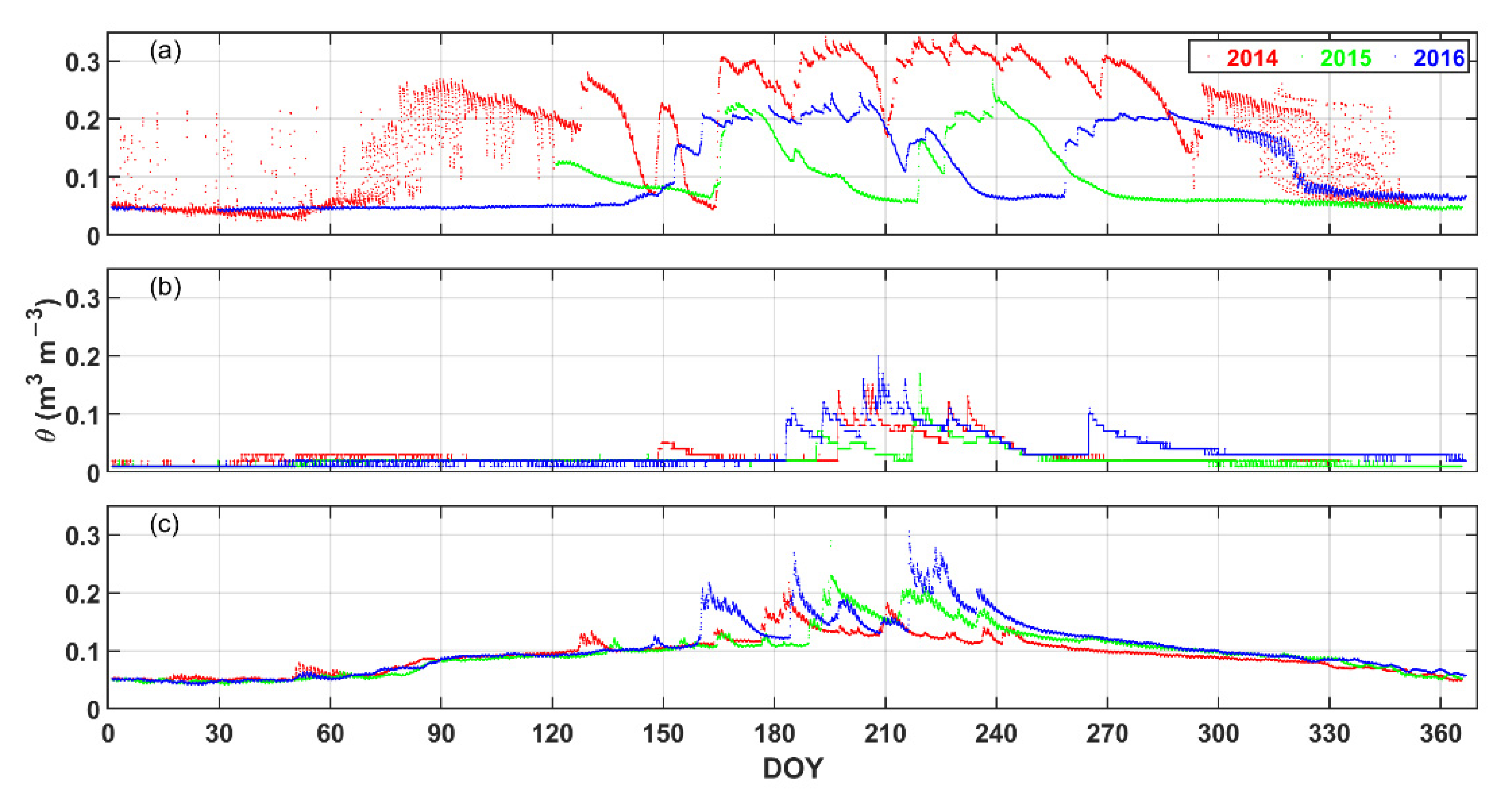
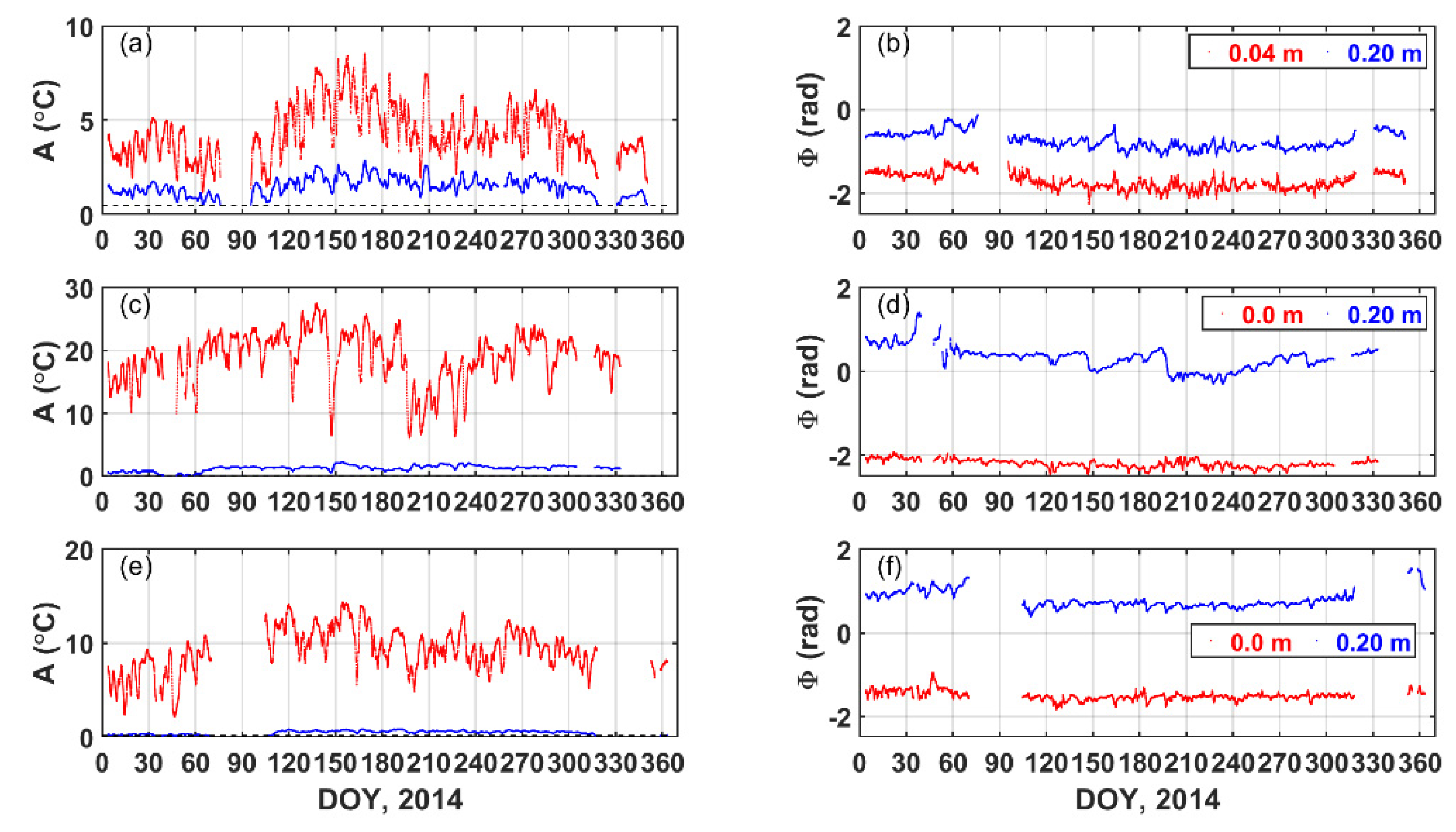



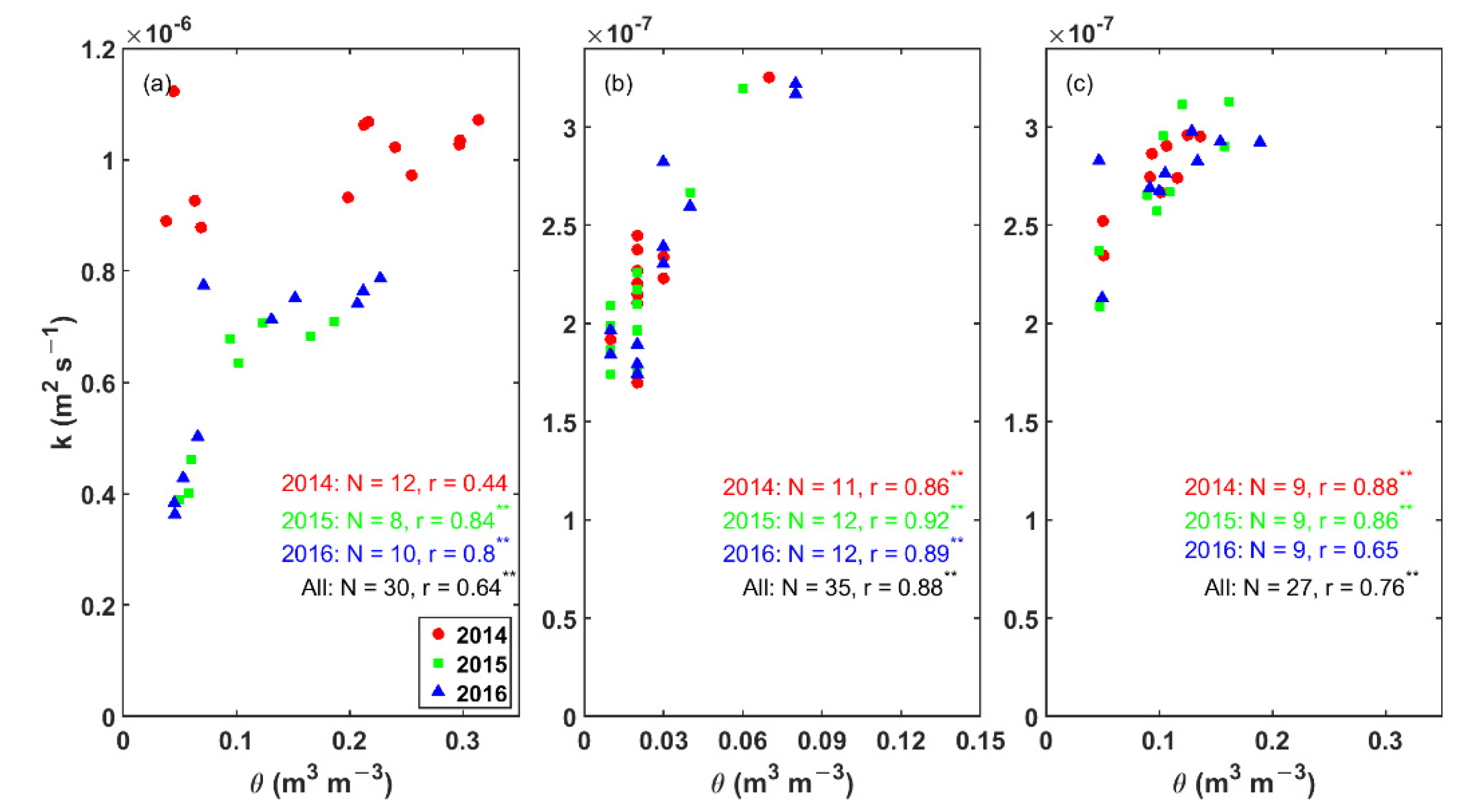
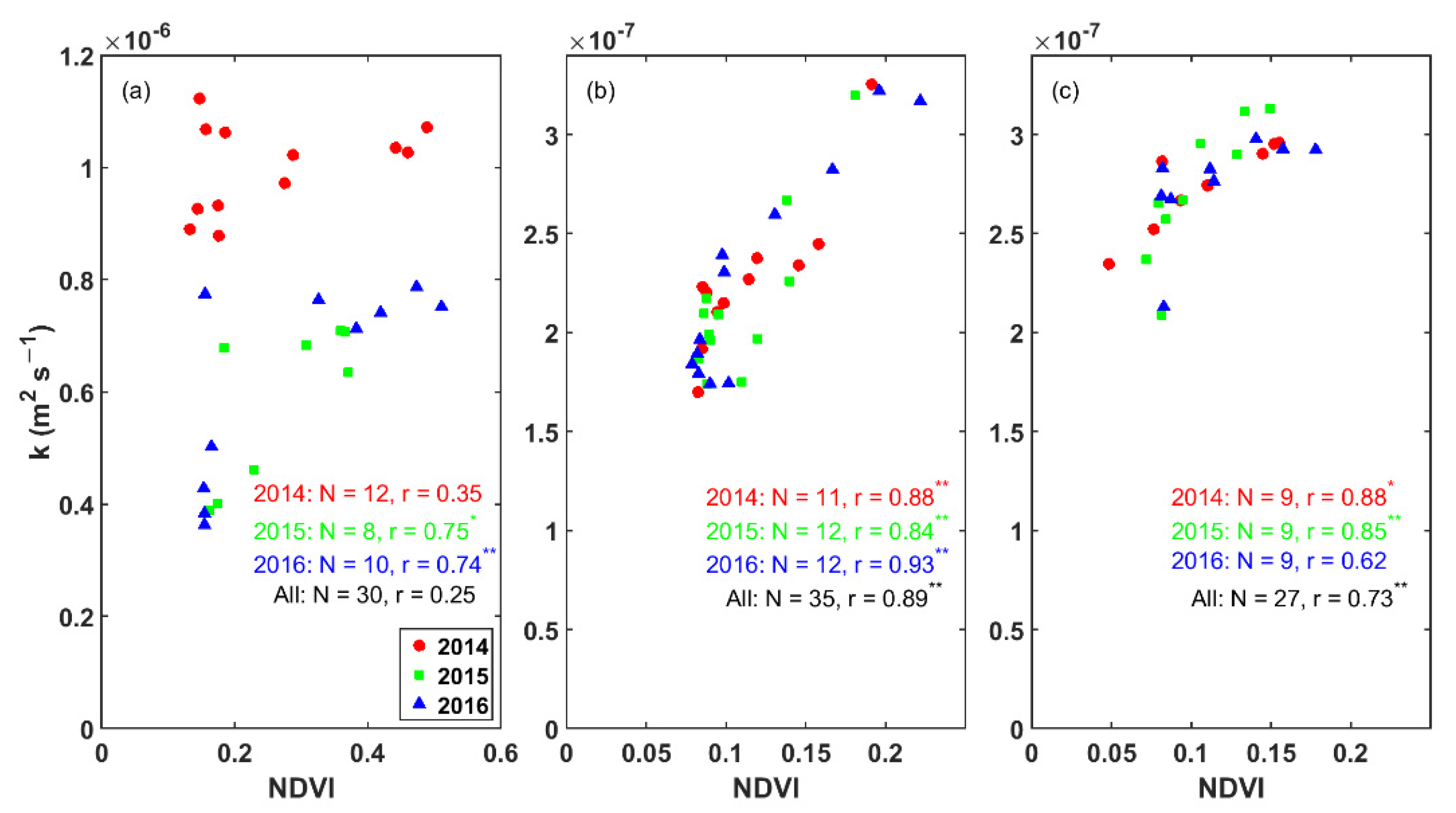

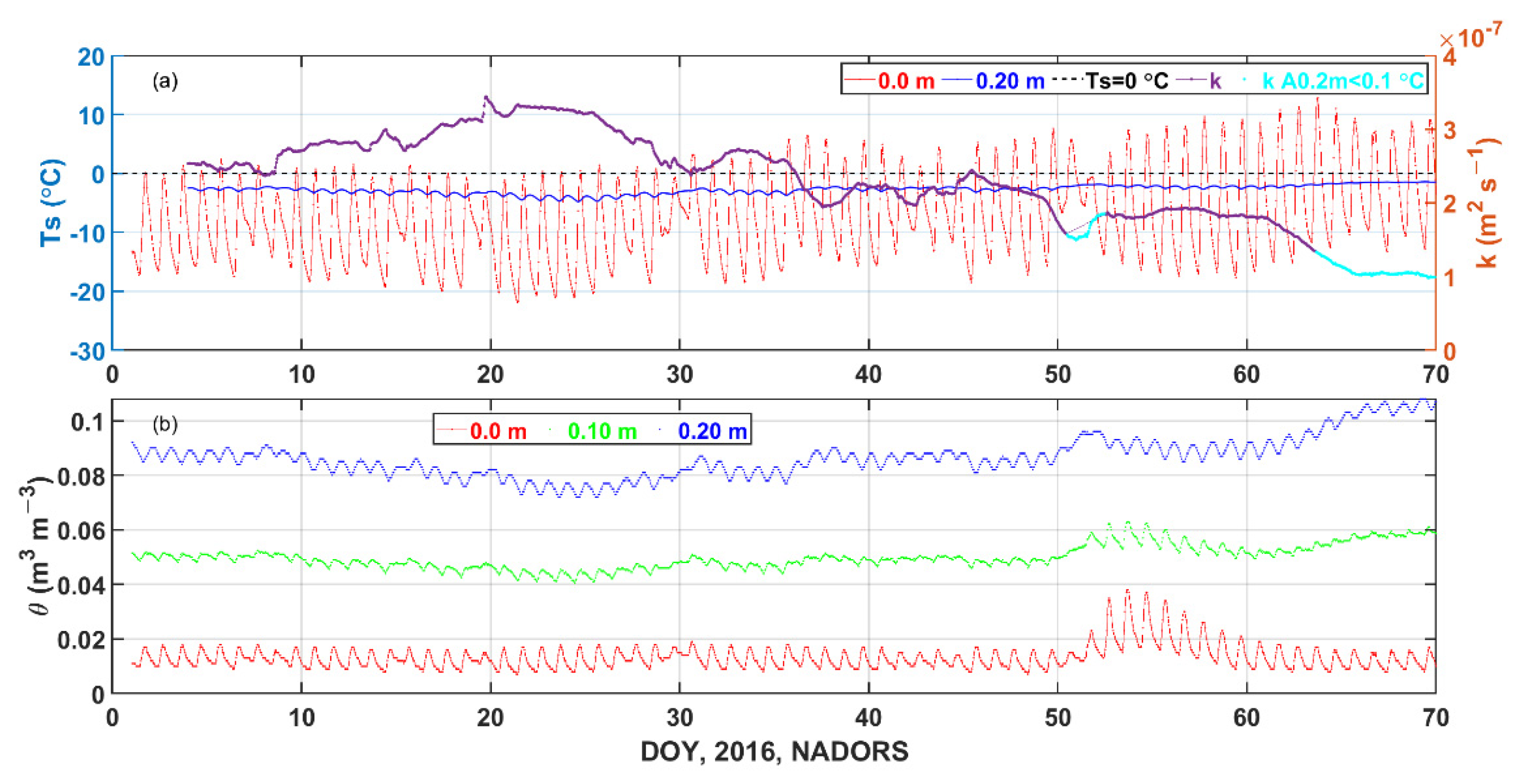
| Site | Latitude | Longitude | Elevation (m) | Land Cover | Soil Type |
|---|---|---|---|---|---|
| BJ | 31.37°N | 91.90°E | 4509 | Alpine meadow | Sandy silt loam |
| QOMS | 28.36°N | 86.95°E | 4298 | Alpine desert | Sand and gravel |
| NADORS | 33.39°N | 79.70°E | 4270 | Alpine desert | Sand and gravel |
| Site | Variables | Senser Models | Manufactures | Depths | Accuracy | Units |
|---|---|---|---|---|---|---|
| BJ | Tsoil | TS-301/TR-219L | Okazak/ Tri-Tronics | 0.04/0.10/0.20 m; 0.05/0.10/0.20 m | Unknown | °C |
| θ | CS616-L | Campbell | 0.04/0.20 m; 0.05/0.10/0.20 m | ±2.5% θ | m3 m−3 | |
| QOMS | Tsoil | Model 107 | Campbell | 0.0/0.10/0.20 m | ≤±0.01 °C | °C |
| θ | CS616 | Campbell | 0.0/0.10/0.20 m | ±2.5% θ | m3 m−3 | |
| NADORS | Tsoil | CSI 109 | Campbell | 0.0/0.20 m | ≤±0.03 °C | °C |
| θ | CS616 | Campbell | 0.0/0.20 m | ±2.5% θ | m3 m−3 |
| Month | BJ | QOMS | NADORS | ||||||
|---|---|---|---|---|---|---|---|---|---|
| 2014 | 2015 | 2016 | 2014 | 2015 | 2016 | 2014 | 2015 | 2016 | |
| 1 | 11.2 ± 0.8 | - 1 | - | 1.9 ± 0.1 | 1.9 ± 0.1 | 1.9 ± 0.1 | 2.6 ± 0.1 | 2.3 ± 0.2 | 2.9 ± 0.3 |
| 2 | 9.0 ± 0.6 | - | 3.8 ± 0.3 | 1.7 ± 0.3 | 1.8 ± 0.2 | 1.9 ± 0.1 | 2.4 ± 0.2 | 2.1 ± 0.3 | 2.2 ± 0.3 |
| 3 | 9.0 ± 1.4 | - | 3.7 ± 0.5 | 2.2 ± 0.1 | 2.2 ± 0.1 | 1.9 ± 0.0 | - | - | - |
| 4 | 11.2 ± 2.3 | - | 4.3 ± 0.2 | 2.2 ± 0.0 | 2.1 ± 0.1 | 1.8 ± 0.0 | 2.9 ± 0.2 | 2.7 ± 0.2 | 2.8 ± 0.2 |
| 5 | 9.1 ± 1.1 | 6.9 ± 0.8 | 5.2 ± 1.0 | 2.2 ± 0.3 | 2.0 ± 0.0 | 1.7 ± 0.0 | 2.7 ± 0.1 | 2.6 ± 0.1 | 2.7 ± 0.1 |
| 6 | 9.3 ± 1.6 | 6.5 ± 1.2 | 7.4 ± 0.7 | 2.4 ± 0.3 | 1.8 ± 0.0 | 1.9 ± 0.0 | 2.8 ± 0.1 | 2.7 ± 0.1 | 2.8 ± 0.1 |
| 7 | 10.3 ± 0.9 | 6.1 ± 1.2 | 7.9 ± 0.6 | 2.7 ± 0.7 | 2.5 ± 0.5 | 3.2 ± 0.3 | 3.0 ± 0.1 | 2.9 ± 0.2 | 2.9 ± 0.1 |
| 8 | 10.8 ± 0.9 | 6.7 ± 1.3 | 6.9 ± 1.5 | 3.3 ± 0.2 | 3.2 ± 0.3 | 3.2 ± 0.3 | 3.0 ± 0.1 | 3.1 ± 0.1 | 2.9 ± 0.1 |
| 9 | 10.6 ± 1.0 | 6.7 ± 0.9 | 7.1 ± 1.2 | 2.4 ± 0.2 | 2.3 ± 0.3 | 2.9 ± 0.3 | 2.9 ± 0.1 | 3.1 ± 0.1 | 3.0 ± 0.1 |
| 10 | 10.1 ± 0.7 | 4.6 ± 0.2 | 7.7 ± 0.5 | 2.4 ± 0.2 | 2.0 ± 0.0 | 2.6 ± 0.1 | 2.8 ± 0.1 | 2.9 ± 0.1 | 2.7 ± 0.2 |
| 11 | 10.3 ± 1.2 | 3.9 ± 0.6 | - | 2.2 ± 0.0 | 2.1 ± 0.0 | 2.4 ± 0.0 | - | - | - |
| 12 | 8.8 ± 0.8 | 3.8 ± 0.2 | 7.6 ± 0.8 | - | 1.9 ± 0.1 | 2.3 ± 0.0 | - | - | - |
| Site | 2014 | 2015 | 2016 | All |
|---|---|---|---|---|
| BJ | 0.82 ** 1 | 0.75 * 2 | 0.86 ** | 0.69 ** |
| QOMS | 0.73 * | 0.87 ** | 0.92 ** | 0.86 ** |
| NADORS | 0.87 ** | 0.88 ** | 0.91 ** | 0.86 ** |
Publisher’s Note: MDPI stays neutral with regard to jurisdictional claims in published maps and institutional affiliations. |
© 2022 by the authors. Licensee MDPI, Basel, Switzerland. This article is an open access article distributed under the terms and conditions of the Creative Commons Attribution (CC BY) license (https://creativecommons.org/licenses/by/4.0/).
Share and Cite
Tong, B.; Xu, H.; Horton, R.; Bian, L.; Guo, J. Determination of Long-Term Soil Apparent Thermal Diffusivity Using Near-Surface Soil Temperature on the Tibetan Plateau. Remote Sens. 2022, 14, 4238. https://doi.org/10.3390/rs14174238
Tong B, Xu H, Horton R, Bian L, Guo J. Determination of Long-Term Soil Apparent Thermal Diffusivity Using Near-Surface Soil Temperature on the Tibetan Plateau. Remote Sensing. 2022; 14(17):4238. https://doi.org/10.3390/rs14174238
Chicago/Turabian StyleTong, Bing, Hui Xu, Robert Horton, Lingen Bian, and Jianping Guo. 2022. "Determination of Long-Term Soil Apparent Thermal Diffusivity Using Near-Surface Soil Temperature on the Tibetan Plateau" Remote Sensing 14, no. 17: 4238. https://doi.org/10.3390/rs14174238





